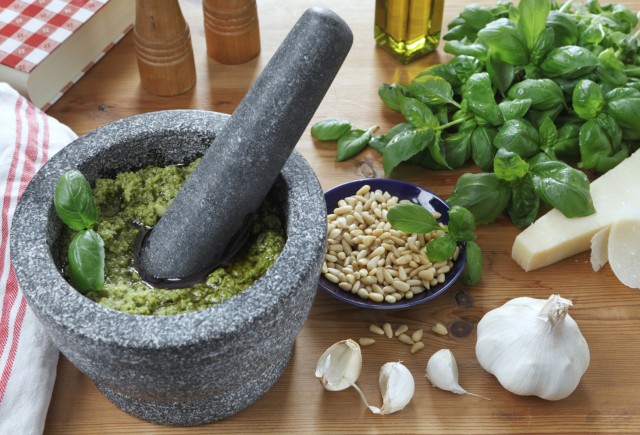Italy is famous for so many dishes in and outside the Country, and pesto is definitely one of these.
Pesto is a typical sauce from Genoa, made with basil, pine nuts, garlic, parmesan and pecorino cheese that doesn’t need to be cooked, because it can be prepared in minutes by hands, without stoves or other electrical helps. It takes its name from the act that you need to do to make it: “pestare” in English means “to pound”. In fact, you need to constantly pound basil leaves with other ingredients, to obtain this fabulous sauce, in the end. Pesto has fairly recent origins, various texts and studies in fact show that the birth of pesto is around mid-1800 ‘s, when this delicious sauce was prepared using the parmigiano crusts to avoid any wasting of food. This sauce was used by low social classes, not for pasta as we do today, but to flavor up soups that weren’t very tasty, because they were made with very poor and few ingredients. Pesto was also not prepared using basil, in the beginning, as a main ingredient, but they used to make it using a variety of different spices, such as marjoram and parsley, pounded in a mortar, with a wood pestle.
It’s in 1863 that the first “official” recipe to prepare pesto was written, by John the Baptist in his book ““La Cuciniera Genovese””, considered the first and most comprehensive book about Ligurian cooking, which described how to make it: “take a clove of garlic, basil (or marjoram and parsley), cheese and grated Parmesan cheese mixed together and pounded all in a mortar with a little butter until both reduced. Melt it then with fine oil in abundance. With this beat serve with lasagna and gnocchi (trofie), with a bit of hot water without salt to make it more liquid. “
To prepare the pesto you must follow a few basic rules to avoid to make a bitter sauce, which can happen if you don’t work the basil leaves properly.
Ingredients:
60 fresh big basil leaves
5 tablespoons grated Parmesan cheese
4 tablespoons pecorino romano cheese
a pinch of sea salt
6 tablespoons pine nuts
2 cloves of garlic, to taste
80 ml olive oil
How to:
Wash the basil leaves and dry them gently with paper towels, without breaking them.
Put the garlic in a mortar and start poundind it to reduce into a puree.
Next add the basil leaves a few at a time, pounding them in a circular motion with a few grains of salt to preserve the bright color.
Once finished, put in the mortar all the basil leaves, add the pine nuts and start pounding again with circular movements. Add Parmesan and pecorino gradually, alternating with a drizzle of olive oil each time and pound again, until you’ll obtain a nice and very tasty sauce.
Pesto can be stored in the refrigerator, covered, for about 3 or 4 days.
Pesto is a typical sauce from Genoa, made with basil, pine nuts, garlic, parmesan and pecorino cheese that doesn’t need to be cooked, because it can be prepared in minutes by hands, without stoves or other electrical helps. It takes its name from the act that you need to do to make it: “pestare” in English means “to pound”. In fact, you need to constantly pound basil leaves with other ingredients, to obtain this fabulous sauce, in the end. Pesto has fairly recent origins, various texts and studies in fact show that the birth of pesto is around mid-1800 ‘s, when this delicious sauce was prepared using the parmigiano crusts to avoid any wasting of food. This sauce was used by low social classes, not for pasta as we do today, but to flavor up soups that weren’t very tasty, because they were made with very poor and few ingredients. Pesto was also not prepared using basil, in the beginning, as a main ingredient, but they used to make it using a variety of different spices, such as marjoram and parsley, pounded in a mortar, with a wood pestle.
It’s in 1863 that the first “official” recipe to prepare pesto was written, by John the Baptist in his book ““La Cuciniera Genovese””, considered the first and most comprehensive book about Ligurian cooking, which described how to make it: “take a clove of garlic, basil (or marjoram and parsley), cheese and grated Parmesan cheese mixed together and pounded all in a mortar with a little butter until both reduced. Melt it then with fine oil in abundance. With this beat serve with lasagna and gnocchi (trofie), with a bit of hot water without salt to make it more liquid. “




